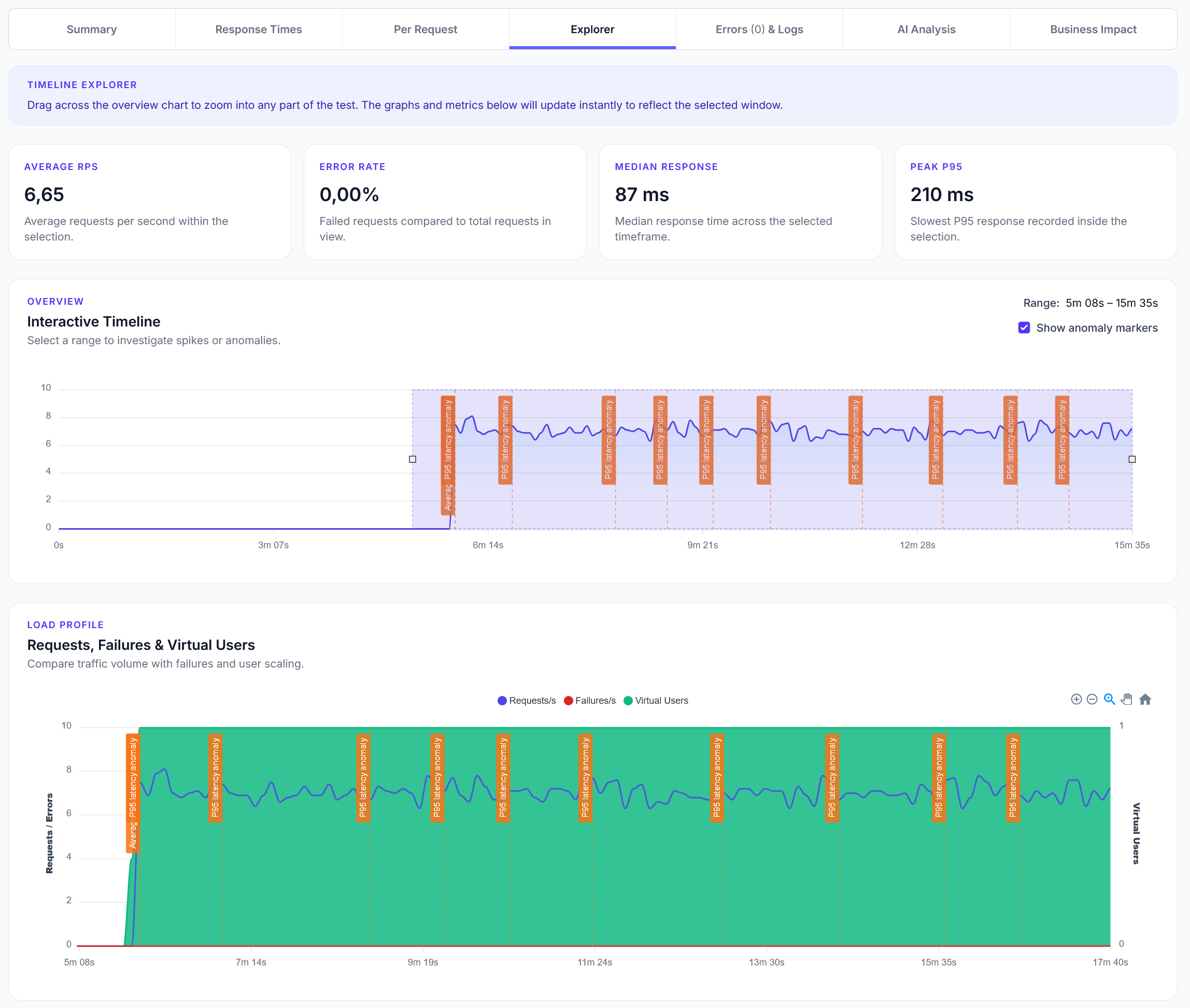
Explorer reports addition
We have added a new Explorer feature to reports, with a timeline scrubber and easy anomaly detection.
Basic chaos engineering with random failures, timeouts, and error injection to test system resilience
LoadForge can record your browser, graphically build tests, scan your site with a wizard and more. Sign up now to run your first test.
This guide shows how to introduce controlled chaos into your load tests to validate system resilience. Perfect for testing how your application handles failures and unexpected conditions.
from locust import task, HttpUser
import random
import time
class ChaosTestUser(HttpUser):
def on_start(self):
# Chaos configuration
self.chaos_enabled = True
self.failure_rate = 0.1 # 10% of requests will have chaos
# Test endpoints
self.endpoints = [
"/api/users",
"/api/products",
"/api/orders",
"/api/health"
]
# Chaos scenarios
self.chaos_scenarios = [
"timeout",
"slow_response",
"random_failure",
"bad_request"
]
@task(4)
def normal_request(self):
"""Normal request that might have chaos injected"""
endpoint = random.choice(self.endpoints)
# Decide if we should inject chaos
if self.chaos_enabled and random.random() < self.failure_rate:
self.inject_chaos(endpoint)
else:
self.make_normal_request(endpoint)
@task(1)
def intentional_chaos(self):
"""Intentionally trigger chaos scenarios"""
endpoint = random.choice(self.endpoints)
scenario = random.choice(self.chaos_scenarios)
print(f"Intentional chaos: {scenario} on {endpoint}")
if scenario == "timeout":
self.test_timeout_resilience(endpoint)
elif scenario == "slow_response":
self.test_slow_response(endpoint)
elif scenario == "random_failure":
self.test_random_failure(endpoint)
elif scenario == "bad_request":
self.test_bad_request(endpoint)
def inject_chaos(self, endpoint):
"""Randomly inject chaos into a request"""
scenario = random.choice(self.chaos_scenarios)
print(f"Chaos injection: {scenario} on {endpoint}")
if scenario == "timeout":
self.test_timeout_resilience(endpoint)
elif scenario == "slow_response":
self.test_slow_response(endpoint)
elif scenario == "random_failure":
self.test_random_failure(endpoint)
else:
self.make_normal_request(endpoint)
def make_normal_request(self, endpoint):
"""Make a normal request without chaos"""
with self.client.get(endpoint, name=f"Normal - {endpoint}") as response:
if response.status_code == 200:
print(f"Normal request to {endpoint}: SUCCESS")
else:
print(f"Normal request to {endpoint}: {response.status_code}")
def test_timeout_resilience(self, endpoint):
"""Test how system handles timeouts"""
try:
with self.client.get(
endpoint,
timeout=0.5, # Very short timeout
name=f"Chaos Timeout - {endpoint}"
) as response:
if response.status_code == 200:
print(f"Timeout test {endpoint}: Surprisingly fast response")
else:
print(f"Timeout test {endpoint}: {response.status_code}")
except Exception as e:
print(f"Timeout test {endpoint}: Timeout occurred (expected)")
# This is expected behavior - system should handle timeouts gracefully
def test_slow_response(self, endpoint):
"""Test system behavior with artificially slow responses"""
# Add artificial delay before request
delay = random.uniform(2.0, 5.0)
time.sleep(delay)
start_time = time.time()
with self.client.get(endpoint, name=f"Chaos Slow - {endpoint}") as response:
response_time = time.time() - start_time
if response.status_code == 200:
print(f"Slow response test {endpoint}: {response_time:.2f}s")
else:
print(f"Slow response test {endpoint}: {response.status_code} in {response_time:.2f}s")
def test_random_failure(self, endpoint):
"""Test random failure scenarios"""
# Simulate different types of failures
failure_types = [
("connection_error", self.simulate_connection_error),
("server_error", self.simulate_server_error),
("client_error", self.simulate_client_error)
]
failure_type, failure_func = random.choice(failure_types)
print(f"Random failure test {endpoint}: {failure_type}")
failure_func(endpoint)
def simulate_connection_error(self, endpoint):
"""Simulate connection errors"""
try:
# Use invalid host to trigger connection error
invalid_url = endpoint.replace(self.host, "http://invalid-host-12345.com")
with self.client.get(
invalid_url,
timeout=2.0,
name=f"Chaos Connection Error - {endpoint}"
) as response:
print(f"Connection error test: Unexpected success")
except Exception as e:
print(f"Connection error test: Failed as expected ({type(e).__name__})")
def simulate_server_error(self, endpoint):
"""Test how system handles server errors"""
# Try to trigger server errors with bad data
bad_data = {"invalid": "data" * 1000} # Large payload
with self.client.post(
endpoint,
json=bad_data,
name=f"Chaos Server Error - {endpoint}"
) as response:
if response.status_code >= 500:
print(f"Server error test {endpoint}: Got {response.status_code} (expected)")
elif response.status_code >= 400:
print(f"Server error test {endpoint}: Got {response.status_code} (client error)")
else:
print(f"Server error test {endpoint}: Unexpected success {response.status_code}")
def simulate_client_error(self, endpoint):
"""Test client error handling"""
# Send malformed requests
malformed_scenarios = [
("invalid_json", '{"invalid": json}'),
("missing_content_type", {"data": "test"}),
("wrong_method", "DELETE")
]
scenario, data = random.choice(malformed_scenarios)
if scenario == "invalid_json":
with self.client.post(
endpoint,
data=data, # Invalid JSON string
headers={"Content-Type": "application/json"},
name=f"Chaos Invalid JSON - {endpoint}"
) as response:
print(f"Invalid JSON test {endpoint}: {response.status_code}")
elif scenario == "missing_content_type":
with self.client.post(
endpoint,
json=data,
headers={"Content-Type": "text/plain"}, # Wrong content type
name=f"Chaos Wrong Content-Type - {endpoint}"
) as response:
print(f"Wrong content-type test {endpoint}: {response.status_code}")
elif scenario == "wrong_method":
with self.client.delete(
endpoint,
name=f"Chaos Wrong Method - {endpoint}"
) as response:
print(f"Wrong method test {endpoint}: {response.status_code}")
def test_bad_request(self, endpoint):
"""Test bad request handling"""
# Send requests with bad parameters
bad_params = {
"invalid_param": "value",
"limit": -1, # Invalid limit
"page": "not_a_number" # Invalid page
}
with self.client.get(
endpoint,
params=bad_params,
name=f"Chaos Bad Request - {endpoint}"
) as response:
if response.status_code == 400:
print(f"Bad request test {endpoint}: Properly rejected (400)")
elif response.status_code == 200:
print(f"Bad request test {endpoint}: Accepted bad params (potential issue)")
else:
print(f"Bad request test {endpoint}: {response.status_code}")
@task(1)
def test_system_recovery(self):
"""Test if system recovers after chaos"""
# First, cause some chaos
endpoint = random.choice(self.endpoints)
self.inject_chaos(endpoint)
# Wait a bit
time.sleep(1)
# Then test if system is still responsive
with self.client.get(endpoint, name=f"Recovery Test - {endpoint}") as response:
if response.status_code == 200:
print(f"Recovery test {endpoint}: System recovered successfully")
else:
print(f"Recovery test {endpoint}: System still having issues ({response.status_code})")
Watch for: